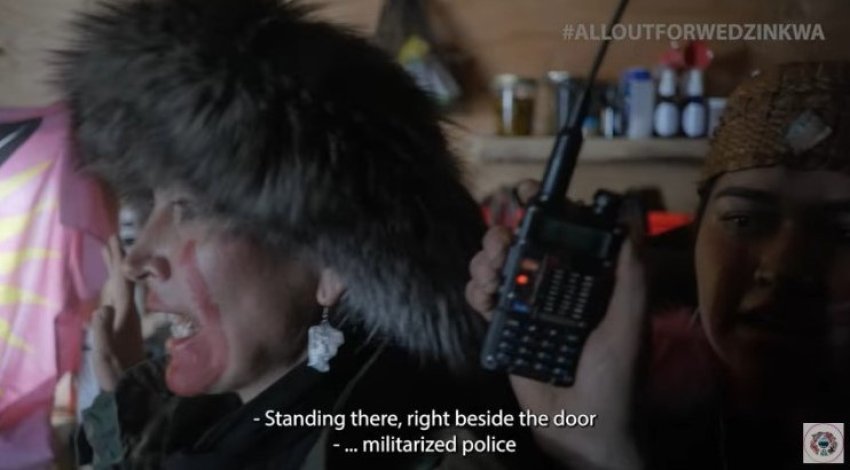
An abuse of process hearing started in British Columbia on January 12 against the Royal Canadian Mounted Police (RCMP) and their infamous Community-Industry Response Group (C-IRG) for violence inflicted on Indigenous land defenders opposing construction of the Coastal GasLink fracked gas pipeline across unceded Wet’suwet’en territory.
The trial relates to the conviction on January 12 of three Indigenous land defenders — Sleydo’ Molly Wickham (Wet’suwet’en), Shaylynn Sampson (Gitxsan) and Corey Jocko (Haudenosaunee) — who were arrested in 2021 and found guilty of criminal contempt for violating a 2018 injunction served on behalf of the company. The injunction prevents anyone from blocking access routes or work sites used for pipeline construction.
The C-IRG is a secretive assault unit of the military RCMP, and little is known publicly about its structure or operational procedures and directives. The court case has shone some light on this otherwise shadowy outfit. What it revealed is a unit marked by racism, contempt and abuse against Indigenous people — all hallmarks of the RCMP itself historically.
Still, some of what was revealed was stomach-churning for observers.
An RCMP field of colonial war
Sleydo’, Sampson and Jocko filed abuse of process applications with the court related to their arrests and charges, arguing that the RCMP used excessive force. They also claim they were treated unfairly while in custody. Their filing asks the judge to stay their charges, or, if not, to find it appropriate to reduce their sentences based on their treatment by police.
The first thing that emerged was confirmation that RCMP had deployed snipers, as part of its “lethal overwatch” strategy against land defenders. This admission came from testimony provided by Sergeant Ryan Arnold of the Emergency Response Team (ERT). Arnold said: “We were there to provide lethal-force overwatch for the tac [tactical] team to go hands-on with people who need to be arrested.”
Other forms of violence were deployed or threatened against the land defenders who had been sheltering in a tiny house on site.
One officer, Corporal Sebastien Pilote, suggested sending a police dog into the tiny house.
Instead of standard issue “breaching devices”, officers used axes, a sledgehammer and a chainsaw that they found at the site. Once the door was breached, Pilote pointed a 40mm projectile launcher at the land defenders.
Pilote had also wanted to fire a weapon at a security camera on the tiny house, which would have risked serious harm or fatality for people inside. He was dissuaded from doing so and instructed to simply cut the cable.
The RCMP also showed a stunning lack of knowledge or recognition of Indigenous symbols and phrases.
Under questioning, RCMP Superintendent James Elliott admitted mischaracterising a statement on social media about “burying weapons” as a threat. He said: “I remember one post that I was provided at the time that said something about hiding weapons under the snow, in the forest. I was required to make sure that those resources were there and properly staffed to deal with them.”
Defence lawyer Frances Mahon told Elliott that the post was referring to a Haudenosaunee expression of peace and read out the full text of the post. “‘Even in the eye of the storm, there is great peace. We must all bury our weapons underneath the pines.’” Mahon asked, “Sir, are you familiar with the common expression ‘burying the hatchet’? Do you know what that means?”
Another key moment came when Elliott revealed the military lens through which the RCMP view the Mohawk flag. The RCMP had been quite concerned by solidarity shown by the Mohawk Warrior Society to Wet’suwet’en land defenders. They view the society as akin to a terrorist group, posing a potential for “enhanced activism”.
“Are you aware... that it is also intended to be a visual manifestation of the Haudenosaunee oral constitution, sometimes described as the Great Law of Peace?” asked Mahon.
“Are you aware, sir, that the Mohawk word for warrior has a different connotation than how we understand that in English?”
Mahon said the Haudenosaunee word for warrior is Rotisken’rakéhte, meaning “he carries the burden of peace”.
Elliott confirmed that the RCMP had no intention of negotiating a peaceful resolution. In his words: “There was not going to be any negotiation. There was quite a bit of destruction on the roads and the time for setting conditions and negotiations was over. There was criminal and injunction violations occurring, and we needed to enforce that.” This despite the fact that Arnold testified that ERT teams normally include a negotiator.
Racist colonial framings
The jaw-dropping moment in the trial came when audio was played in which an RCMP officer described an Indigenous person who had been arrested as “that big fucking ogre-looking dude”. Officers respond with laughter before the speaker continues: “He’s actually, like, autistic. Then the fucking guys just beat the shit out of him and then he started crying. I felt bad for him. Apparently the sergeant grabbed his balls and twisted. I guess he was on the ground and everyone was just grabbing limbs. He didn’t have a limb to grab, so he’s like, just grab his balls, like, ‘You done now? You done resisting?’”
This was not the only explicitly racist statement by RCMP officers caught on tape. Officers were heard making degrading comments about symbols worn by Indigenous women to honour murdered and missing Indigenous women and girls. Sleydo’ and Sampson were wearing red dresses and red handprints in paint on their faces. One officer was heard saying, “Do they have fucking face paint, too? They’re not orcs?” (Fans of JRR Tolkien and Lord of the Rings or Dungeons and Dragons will know the controversies over the racist framings and implications behind orc references.)
Elliott apologised to the court for the language used by his officers. This rings hollow, however, given the colonial history of the RCMP and documented racism within its ranks.
The hearing was supposed to last two weeks, but was adjourned after one. It is scheduled to resume from June 17‒21.